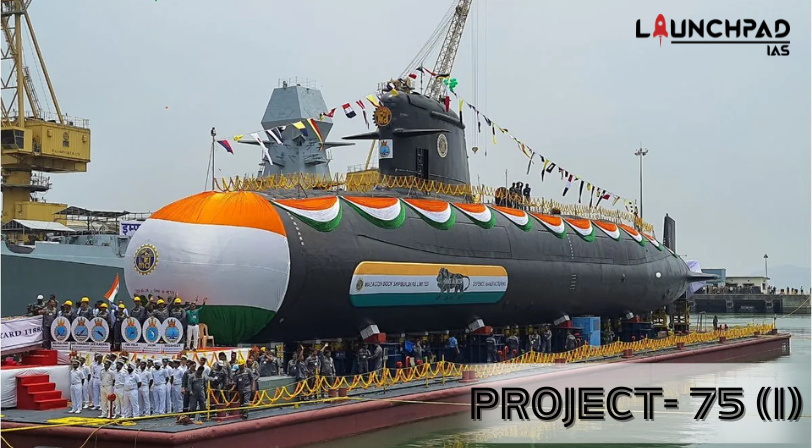- Project 75 (I) is a submarine-building project of the Indian Navy. Under this project, Govt. will build 6 non-nuclear submarines. This project will be a predecessor of Project 75 of the Indian Navy. But will improve in design and stealth of the submarine.
- This project envisages the indigenous construction of submarines equipped with a state-of-the-art Air air-independent propulsion system
- Project 75 (I), approved in 2007, is part of the Indian Navy’s 30-year Plan for indigenous submarine construction.
- Project 75 (I) will be the first under the strategic partnership model which was promulgated in 2017 to boost indigenous defence manufacturing. The strategic partnership model allows domestic defense manufacturers to join hands with leading foreign defense majors to produce high-end military platforms to reduce import dependence.
- Acquisitions under the Strategic Partnership model refer to the participation of private Indian firms along with foreign OEM (Original Equipment Manufacturers) in the ‘Make in India’ defence.
Difference between Project 75 and Project 75 (I)?
- Project 75 (I) is a follow-up to Project 75 and improves upon the design and technology of its predecessor.
- The conventional diesel-electric submarines such as the Scorpene, under Project 75, come with improved stealth features such as advanced acoustic absorption techniques, low radiated noise levels, long-range guided torpedoes, tube-launched anti-ship missiles, sonars and sensor suites.
- However, as electrical batteries power them, they need to surface every 48 hours to be recharged.
- The AIP technology will improve on this in Project 75 (I) building six submarines that can stay submerged for up to two weeks. These submarines may even be larger compared to the ones under Project 75.
What is the Air Independent Propulsion System?
- AIP is a technology for conventional non-nuclear submarines.
- Submarines are essentially of two types: conventional and nuclear.
- Conventional submarines use diesel-electric engines, which require them to surface almost daily to get atmospheric oxygen for fuel combustion.
- If fitted with an AIP system, the submarine will need to take in oxygen only once a week.
- The indigenously developed AIP, which is one of the key missions of the Naval Materials Research Laboratory (NMRL – DRDO), is considered one of the ambitious projects of the DRDO (Defence Research and Development Organisation) for the Navy.
Fuel Cell-Based AIP system
- In a fuel cell-based AIP, an electrolytic fuel cell releases energy by combining hydrogen and oxygen, with only water as the waste product ensuring less marine pollution.
- The cells are highly efficient and do not have moving parts, thus ensuring that the submarine has a low acoustic emission of sound.
What are the Advantages and Disadvantages of AIP?
Advantages of AIP:
- AIP has a force multiplier effect on the lethality of a diesel-electric submarine as it enhances the submerged endurance of the boat severalfold.
- Fuel cell-based AIP has merits in performance compared to other technologies.
- AIP technology allows a conventional submarine to remain submerged for much longer than ordinary diesel-electric submarines.
- All conventional submarines have to surface to run their generators that recharge the batteries that allow the boat to function underwater.
- However, the more frequently a submarine surfaces, the higher the chances of it being detected.
- AIP allows a submarine to remain submerged for more than a fortnight, compared to two to three days for diesel-electric boats.
Disadvantages of AIP:
- Installing AIP increases the length and weight of the boats, and requires pressurized liquid oxygen (LOX) storage on-board and supply for all three technologies.
- MESMA (Autonomous Submarine Energy Module) and the Stirling engine have some acoustic noise from moving parts, and the submarine’s unit cost increases by around 10%.


